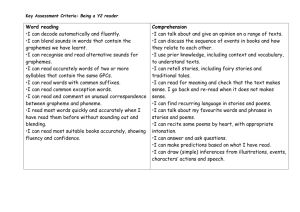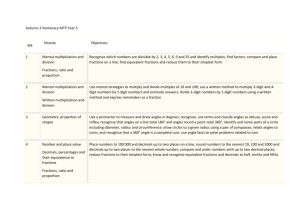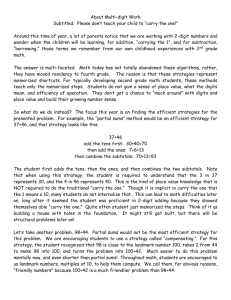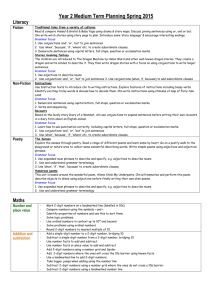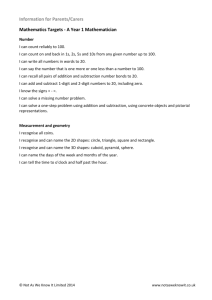Step 2 number targets
advertisement
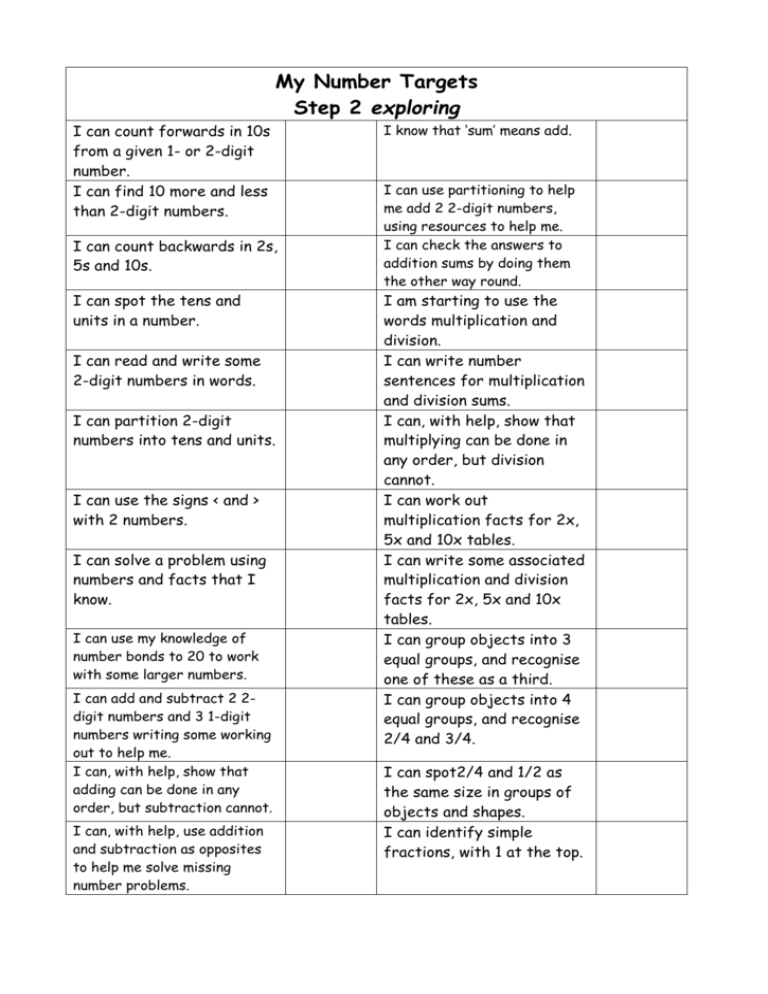
My Number Targets Step 2 exploring I can count forwards in 10s from a given 1- or 2-digit number. I can find 10 more and less than 2-digit numbers. I can count backwards in 2s, 5s and 10s. I can spot the tens and units in a number. I can read and write some 2-digit numbers in words. I can partition 2-digit numbers into tens and units. I can use the signs < and > with 2 numbers. I can solve a problem using numbers and facts that I know. I can use my knowledge of number bonds to 20 to work with some larger numbers. I can add and subtract 2 2digit numbers and 3 1-digit numbers writing some working out to help me. I can, with help, show that adding can be done in any order, but subtraction cannot. I can, with help, use addition and subtraction as opposites to help me solve missing number problems. I know that ‘sum’ means add. I can use partitioning to help me add 2 2-digit numbers, using resources to help me. I can check the answers to addition sums by doing them the other way round. I am starting to use the words multiplication and division. I can write number sentences for multiplication and division sums. I can, with help, show that multiplying can be done in any order, but division cannot. I can work out multiplication facts for 2x, 5x and 10x tables. I can write some associated multiplication and division facts for 2x, 5x and 10x tables. I can group objects into 3 equal groups, and recognise one of these as a third. I can group objects into 4 equal groups, and recognise 2/4 and 3/4. I can spot2/4 and 1/2 as the same size in groups of objects and shapes. I can identify simple fractions, with 1 at the top. My Number Targets Step 2 achieving I can count forwards and backwards in 10s from a given 2-digit number. I can find 10 more and less than 3-digit numbers. I can count forwards in 3s. I know that ‘difference’ means subtract. I can say the value of each digit in a 2-digit number. I know that grouping and sharing means division, and times and lots of means multiplication. I can write number sentences for multiplication and division sums including ones with missing numbers. I can show using sums that multiplying can be done in any order, but division cannot. I can work out division facts for 2x, 5x, 10x tables. I can write all associated multiplication and division facts for 2x, 5x and 10x tables. I can recognise shapes divided into 3 equal pieces and name on of these as a third. I can recognise shapes divided into 4 equal pieces and name 2/4 and 3/4. I can count in quarters, using 1/2 for 2/4. I can read and write all 2digit numbers in words. I can partition 2-digit numbers in different ways, for example 54 = 50 + 4 and 40 + 14 and 52 + 2. I can use the signs <, > and = with groups of numbers. I can solve a problem using numbers and facts that I know. I can use my knowledge of number bonds to find related facts for numbers to 100. I can add and subtract 2 2digit numbers and 3 1-digit numbers in my head. I can show using sums that adding can be done in any order, but subtract cannot. I can use addition and subtraction as opposites to help me solve missing number problems. I can use partitioning to help me add 2 2-digit numbers. I can check the answers to subtraction sums by using a related addition sum. I can work out simple fractions (with 1 at the top) of small numbers. My Number Targets Step 2 B&D I can count forwards and backwards in 20s from a given 2- or 3-digit number. I can explain how to work out 10 more and less than a number. I can count forwards and backwards in 3s from any given number. I can solve problems using my understanding of place value of 2-digit numbers. I can read and write some 3-digit numbers in words. I can use different partitions of a number to help me in mental calculations. I can solve problems involving < and >. I can solve a problem using numbers and facts that I know. I can use my knowledge of number facts to 100 to solve problems. I can keep a running total of adding up in my head. I can explain why the order of numbers in a subtraction sum matters but does not for addition. I can use addition and subtraction as opposites to help me solve complex missing number problems. I can explain that to find the difference you have to subtract the smaller number from the bigger one. I can use different strategies to add and subtract 2-digit numbers. I can explain why I cannot check a subtraction sum by doing it in a different order. I know lots of different words that mean multiplication and division. I can write my own number sentences for x and ÷ when I am solving problems. I can explain why the order of numbers in a division sum matters but does not for multiplication. I can solve problems using facts from 2x, 5x, 10x tables. I can predict if the answer to a 2x, 5x or 10x question will be odd or even. I can find a third in a range of different situations. I can recognise shapes divided into 3 equal pieces and name 2/3. I can explain that 2/4 is equivalent to 1/2. I can work out simple fractions (with 1 at the top) of larger numbers.

